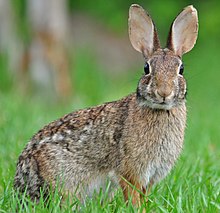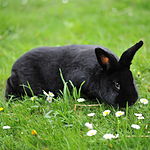Portal:Lagomorpha
The Lagomorpha portalThe lagomorphs (/ˈlæɡəmɔːrf/) are the members of the taxonomic order Lagomorpha, of which there are two living families: the Leporidae (rabbits and hares) and the Ochotonidae (pikas). There are 110 recent species of lagomorph of which 109 are extant, including 10 genera of rabbits (42 species), 1 genus of hare (33 species) and 1 genus of pika (34 species). The name of the order is derived from the Ancient Greek lagos (λαγώς, "hare") + morphē (μορφή, "form"). (Full article...) Selected article
The Jimmy Carter rabbit incident, dubbed the "killer rabbit" attack by the media, involved a swamp rabbit furiously trying to board then-U.S. President Jimmy Carter's fishing boat on April 20, 1979. Press Secretary Jody Powell mentioned the event to Associated Press correspondent Brooks Jackson on August 28, 1979, who filed the story with the wire service the following day. The story "President Attacked by Rabbit" was carried across the front page of The Washington Post, though the White House's refusal to release the photograph resulted in the newspaper using a cartoon parody of the Jaws poster labeled "PAWS" as its illustration. (Full article...)
Selected breed
Despite its name, the Alaska Rabbit originates in Germany. It is a medium-sized rabbit breed, weighing around 3–4 kg (7-9 lb) with glossy black fur. This breed was created in 1900 by crossing Havanas, Dutch, Himalayans and Champagne d'Argents with the goal of obtaining a rabbit that looks like the Alaskan fox. The Alaska Rabbit Club is the British Rabbit Council's national specialty club for this breed.
Selected quote
SubcategoriesRelated portalsSelected imageYoung Hare (German: Feldhase) is a 1502 watercolour and gouache painting by German artist Albrecht Dürer. Painted in 1502 in his workshop, it is acknowledged as a masterpiece of observational art alongside his Great Piece of Turf from the following year. The subject is rendered with almost photographic accuracy, and although the piece is normally given the title Young Hare, the portrait is sufficiently detailed for the hare to be identified as a mature specimen — the German title translates as "Field Hare" and the work is often referred to in English as the Hare or Wild Hare.
Selected video
Did you know"Rabbit" in…Get involvedFor editor resources and to collaborate with other editors on improving Wikipedia's Lagomorpha-related articles, see WikiProject Mammals. Things you can do
TopicsAssociated WikimediaThe following Wikimedia Foundation sister projects provide more on this subject:
|















